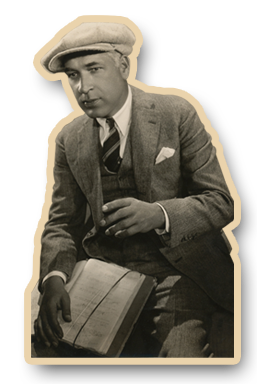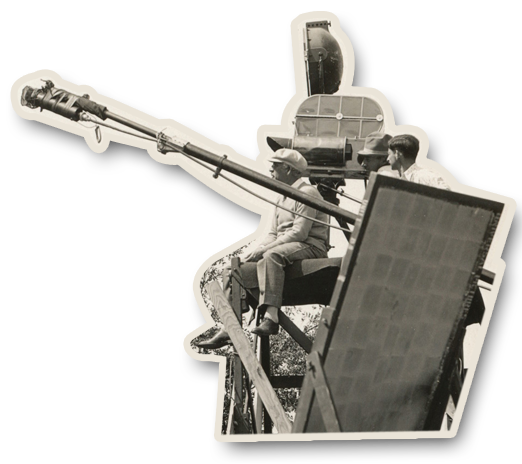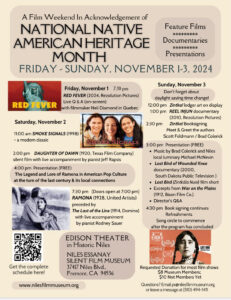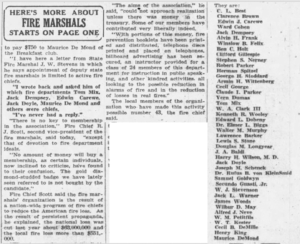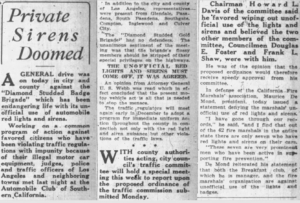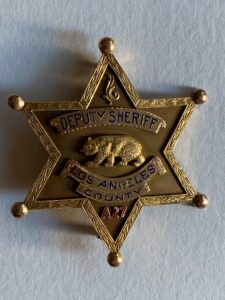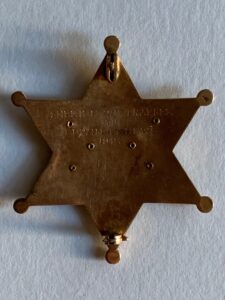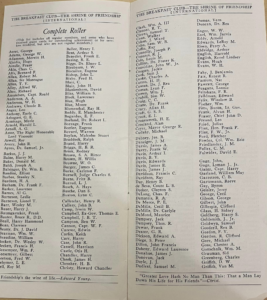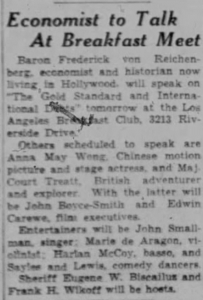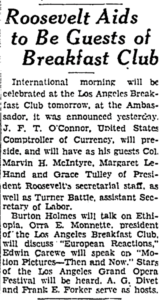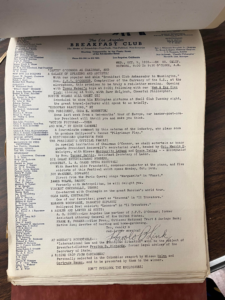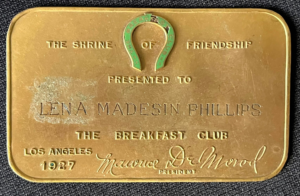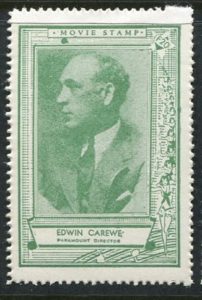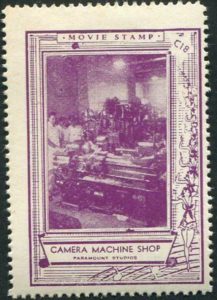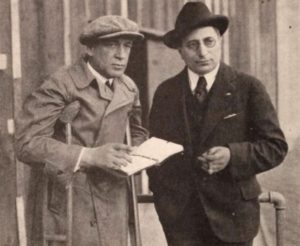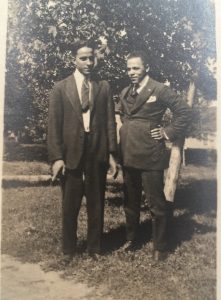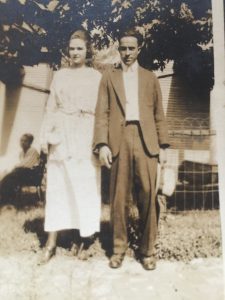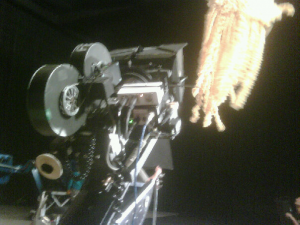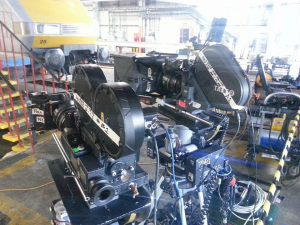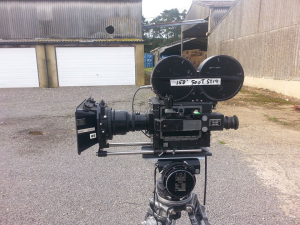We are pleased to announce that a rare clip has become available to view of Edwin acting in his very first film, The Silent Signal. At just 16 seconds long, this snippet is from the archives of the Eye Filmmuseum located in Amsterdam. The small section of film was provided to EFM from a private collector. As you will see, several seconds into the clip, Edwin appears for just a few moments. This is the first and perhaps only existing film media of Edwin acting on screen. It is truly a rare gem which we can now add to the growing collection of artifacts at the Edwin Carewe Legacy Archive. Thanks to the two David’s who shared this with us and to the Eye Filmmuseum for the additional information.
Category Archives: Uncategorized
June Mathis, Silent Film Screenwriter is now the book
We are pleased to announce the publication of June Mathis – The University Press of Kentucky, by author Tom Slater. Edwin and June worked on several movies together and she is widely known for having discovered Rudolph Valentino. You can read further into her life and history by picking up a copy of Tom’s latest book.
|
Edwin Carewe was crucial in helping June Mathis establish herself as a screenwriter. They made seven films together from 1915-1919. While no evidence of their work together exists, this book provides a full discussion of the similarity in their filmmaking philosophies, which very likely contributed to their great success.
Use discount code FA30.
Some early reviews: “Long neglected, June Mathis finally gets her due in this important study of her ground-breaking life and career. Tom Slater, in over 40 years of diligent research, has brought to light the story of a woman who began in films in 1915, who not only wrote, but also edited and produced, including The Four Horsemen of the Apocalypse (1921), the film that made Valentino a star. This book is a significant contribution to our understanding of just how important women were to the actual production of motion pictures during the silent era.” –Joanna E. Rapf, Visiting Professor, Dartmouth College, Film and Media Studies
“”Fantastic. A great contribution to silent cinema history.”—Ruth Barton, author of Rex Ingram: Visionary Director of the Silent Screen
https://www.kentuckypress.com/978198590 … ne-mathis/
@kentuckypress
Ramona at the Edison Theater
We are pleased to announce a new screening of Edwin’s 1928 Ramona, along with other films, in honor of National Native American History Month at the Edison Theater within the Niles Essanay Silent Film Museum in Fremont, California. This event will run November 1-3, 2024 with the screening of Ramona on Saturday, November 2, 7:30pm.
The Diamond Studded Badge Brigade
During our recent quest to discover information about Edwin’s involvement with the Los Angeles Breakfast Club, we came upon a story within the story. In a news article from Wednesday, March 30, 1927, Los Angeles Breakfast Club founder, Maurice DeMond, hatched up a plan to sell a more exclusive level of membership with a diamond studded gold card for $750 each. In today’s dollars, that would be around $3000. Inclusive of the price for the card comes a placard for your car which reads, “Deputy State Fire Marshall.” Some members received an actual siren used by the fire departments and a Deputy Sheriff badge. All this, to thwart driving laws and speed through “traffic” in Los Angeles in the 1920’s. Imagine using this scheme today.
Edwin’s name appears prominently in various news articles about “The Brigade.” It is also a rare notation to see his name printed with the letter J. in reference to his original birth name Jay John Fox. From one of the articles, Edwin is noted alongside Heavyweight Boxing Champion, Jack Dempsey, as members of the posse.
The Sheriff’s badge given to Edwin, was issued by Sheriff W.E. Traeger in 1927. It would appear that quite a scheme was put together by Maurice, Edwin and his pals of the time. The “Badge Brigade” attracted enough attention that California Attorney General, U.S. Webb issued an opinion about the matter and to effectively quash the entire scheme.
The Los Angeles Breakfast Club
The date was May 13, 1927. Edwin was to receive his indoctrination into a most prestigious and elite Hollywood club, The Los Angeles Breakfast Club at 3213 Riverside Drive. We have recently discovered that Edwin was a long-standing member of this elite social club.
Founded in 1925 by Maurice DeMond and a group of Equestrians, the club became a social gathering place by exclusive membership. Each member received a gold name card embossed with a green horseshoe, see sample image. Edwin’s interest in joining the club makes perfect sense considering his deep love for horses and many of his Hollywood pals were members too. Names such as Tom Mix, whom Edwin was very close friends, Cecille B. DeMille, D.W. Grifith, Samuel Goldwyn, Carl Laemmle, Louis B. Mayer, Jack and Sam Warner and Rudolph Valentino just to name a few. You can see Edwin’s name on the 1927 roster image.
In another article dated December 17, 1932, Edwin appears at the club, with fellow film executive John Boyce-Smith during a presentation by British adventurer and explorer Major Chaplin Court Treatt. The article states that Edwin is “with” Major Treatt. This detail raises more questions about the relationship Edwin may have had with Major Treatt who was the mastermind behind the Court Treatt Expedition in 1926 South Africa. Edwin appears again in 1935 as a Presenter at the club alongside aids to then President Roosevelt.
Edwin made at least one film in Africa. “A Son of the Sahara.” When we dig a little deeper into Major Treatt, he was married to Stella Maud Court Treatt, a South African film maker. It is entirely possible that Edwin may have known or collaborated with Stella during his filming in Africa, which could have led to a long relationship with the famous duo.
Regarding Edwin’s gold member card, we have to wonder where it might be today. If anyone has seen this card or might know where it could be, please let us know. We would love to discover its location.
We would like to thank the Historian with The Los Angeles Breakfast Club for reaching out to us with all of this new and exciting information.
10th Anniversary – The Edwin Carewe Legacy Archives
It has been a decade since we launched the Edwin Carewe Legacy Archives website and blog. During this time, there have been many new discoveries. We have enjoyed all of the collaborations with researchers around the globe who have shown an interest in the life, times and work of Edwin Carewe. We thank all who have participated in the creation and management of the website and a special thank you to all the fans who have helped us discover new information about our grandfather, great grandfather and great, great grandfather.
Edwin Carewe and the Big 7
We have recently come into possession of a stamp of Edwin for the archive. This poster stamp was an advertising label, slightly larger than a postage stamp and in this case, created by Paramount Studios as a promotional product. The discovery of a stamp with Edwin listed as “Paramount Director” and using the same photo which is shown in the website gallery, is yet another new discovery.
After further research, it was confirmed that Edwin did work with Paramount Studios on one movie, “The Spoilers” in 1930 starring Gary Cooper. At this time in Edwin’s career, he was working with a powerhouse of people within the Hollywood movie industry. Edwin was already working with all of the big production companies which would eventually spawn “The Big 5” from the Hollywood Golden Era. His involvement with Paramount was one of five from the Big 5 list, Paramount, Fox, RKO Pictures, Warner Bros and MGM.
Since his early years as a Director, Edwin worked with Metro Pictures Company which would later become the first part of the MGM name. Then in 1918 after some 17 movies with Metro, Edwin made his first and only movie with the Goldwyn Productions company headed by Samuel Goldwyn and who would later become the second part of the MGM name.
In 1921 Edwin began a five movie collaboration with Louis B. Mayer and his production company, Louis B. Mayer Productions. With this string of movies, Edwin had completed working with all three original companies which would become MGM Studios in 1924.
After just one movie with Goldwyn, Edwin goes back to Metro for another nine movies but changes productions companies often. He made a few movies with Harold Lockwood and it was common that a production company comes along with the actor or actress. In this case it was Yorke Film Corporation.
In 1919 we have our first record of Edwin using his own production company, Edwin Carewe Productions. This was with a movie called “False Evidence” which was filmed in the Santa Cruz and Felton areas of Northern California.
In 1921, Edwin began a long standing relationship with the production company First National Pictures, which was formed in 1917 by a consortium of movie theaters in direct competition to Adolf Zukor who had founded Paramount. Edwin made some 17 movies in partnership with First National, which would ultimately become Warner Bros in 1928. This checks off the third name on the list of the Big 5.
From 1919 to 1920, Edwin made three movies which were distributed by Pathe Exchange, a subsidiary of the world’s largest film production company, Pathe Company in France. In 1927, Pathe Exchange became American Pathe with a new controlling interest by Joseph P. Kennedy, the philanthropic father to J.F.K. It was through these moves and mergers that RKO Radio Pictures was formed. This checks off the forth name on the list of the Big 5.
This leaves us with Fox Film Corporation. As it turns out, Edwin did work with the founder of Fox Studios, William Fox on one film. The 1922 movie, “Silver Wings” was the only time the two ever worked together. It just so happens that Edwin shared the Director role with another up and coming and future four time Academy winner, Director John Ford. They obviously knew each other well enough to co-Direct this movie together.
There were other important movie studios of the Silent Era which are still in business today. Later in his career, Edwin would work with Universal Studios on two movies, both with the same titles, the 1927 and 1931 “Resurrection.” This was not the first time Edwin would remake a movie that he had made earlier in his career. Universal Studios was founded in 1912 by Carl Laemmle.
In the 1928 movie “Revenge,” Edwin began a three movie partnership with Mary Pickford and her film production company, United Artists. Mary had formed United Artists in 1919 with fellow actors D.W. Griffith, Douglas Fairbanks and Charlie Chaplin. Ultimately, United Artists would become a part of MGM in 1981.
There had been only one other time in Edwin’s long and distinguished Directing career that he had a partnership with Charlie Chaplin. Back in 1921 for the movie “Habit,” both Charlie Chaplin and Louis B. Mayer worked with Edwin on this film with their respective production companies.
With this new discovery of a stamp created of Edwin Carewe by Paramount, this has led to a greater review of his work as a Director and many of the relationships he held with most if not all the big powerhouse names in Hollywood during the Silent Era. Edwin worked with all seven of the big names and which we can justifiably call The Big 7 movie studios of all time. Were there any other Directors of this era who had as much versatility? He was referred to by others at the time as “The Duke.” Was Edwin the First Duke of Hollywood?
Edwin Carewe and Louis B. Mayer on Set
An old photo has surfaced which shows Director Louis B. Mayer and Director Edwin Carewe on location in Truckee, California directing actress Anita Stewart in her latest film, “Playthings of Destiny.” Featured on page 60 of the March 12, 1921 Exhibitors Herald, “Carewe is on crutches after being injured, but this would not affect the film’s schedule.” This collaboration between Edwin and Mayer was their first of five movies together.
Looking back at 1921, Edwin was in a three movie deal with Anita Stewart. This was the first of the three movies. It is important to note this is the year that he met his future wife, Mary Akin, our grandmother. It was at the time when President Warren Harding was about to sign the documents to end World War I. Certainly, it was a dynamic time in the history of Hollywood and Edwin’s growing clout as a Hollywood motion picture Director.
Edwin and Louis B. Mayer worked on some five motion pictures together and while Louis would go on to become a co-founder of the bigger MGM Studios, Edwin clearly held regard for Louis and I suspect the sentiments were shared.
Edwin and Roscoe – True Friends!
As a follow up to an earlier post from last year when it was discovered that Edwin had a close relationship with a gentleman named Roscoe Miller, new photos surfaced from an earlier time period with Edwin, Roscoe and Roscoe’s partner Aloise Wade. These photos were taken in Omaha, Nebraska. The photos clearly show Edwin at a much earlier age which confirms the existence of a long standing friendship between Edwin, Roscoe and the greater family.
According to the story from Naomi, “When Aunt Patsy, who is 95, concentrates on the photos with Edwin and her parents, Aunt Patsy recognizes the trees and the surroundings to be the property of her grandfather, Wesley H. Wade, in Omaha, Nebraska. She also said her grandmother, Bertha Wade, is seen in the background of some of the same photos. Therefore, Aunt Patsy suspects the photos had to be prior to 1922. That means the photos had to be taken sometime around 1920 when Roscoe was 28 years old, Aloise was 21, and Edwin was 37 years old.
Because Omaha is described as “a vibrant entertainment culture …echoing the Harlem Renaissance” in Historical Omaha, Nebraska Newspaper Archives, it is highly suspected that Edwin may have lived there at some point in his life. There were “moving picture show” companies like the Lincoln Theatre making “race films” and casting black people and people of color as performers. Roscoe and Edwin most likely met in Omaha during this thriving period of entertainment with performers like Duke Ellington, Louie Armstrong, and Maceo Pinkard. In fact, Roscoe sang as a Tenor in Maceo Pinkard’s Orchestra according to a newspaper article in the Omaha World Herald dated September 10, 1916. Roscoe was very actively tied to the entertainment industry as well as a “singing waiter” at the Brandeis. Somehow, Roscoe and Edwin’s paths met, and they formed a bond.
Aunt Patsy confirmed that the reason the Miller family ended up living in Los Angeles was because of the famous movie director, screenwriter, producer, Edwin Carewe. Roscoe moved to Los Angeles around 1921 leaving his wife, Aloise, living in Omaha with her father for another year. Eventually joined Roscoe and they had five children. She has fond memories of her childhood with “Mr.
Carewe” visiting and clearly remembers hearing her mother, uncle, and Roscoe say, “What would Carewe say…” quite often.”
This has been a wonderful discovery of an important relationship Edwin shared with Roscoe. A story that was unknown to us until recently. Thank you Naomi for sharing.
Photos courtesy of Naomi Miller McCoy.
1928 Mitchell Blimped Newsreel Camera
It has recently come to our attention that a camera once used by Edwin Carewe has surfaced. This camera, a Mitchell BNC (Blimped Newsreel Camera) with serial number 111, first purchased new in April 1928 as a pair #111 and #112 by Edwin and his production company, First National Pictures. This camera is still being used today in the U.K. and abroad.
The current owner “Justin” has stated that, “I’ve owned it for about 12 years and before that it was used on the VFX unit of various films.”
He further goes on to state, “In the enclosed Photographs the camera is doing commercials for British Railways and Cadbury’s chocolate. The other picture is a commercial in Los Angeles. It has also done jobs for Amtrack (American railways) and for SNCF (French Railways).
Justin became curious as to the nature of its origin and contacted the Mitchell Archives and they were able to determine that the original owner was Edwin Carewe.
Here is a fascinating YouTube video of the history of the Mitchell camera.
At the time, the newly developed Mitchell cameras were considered state-of-the-art. They are often referred to as “The Most Influential Camera Ever Made.” The fact that Edwin purchased two, new and with low serial numbers is an amazing new fact in his story.
Thanks Justin for the contact and information, a piece of Edwin and his history remains with you.
Photos courtesy of Justin P. in the U.K.
